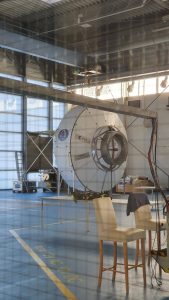What is your name and your role in the Gateway programme?
My name is Tatjana Mandil and I’m a Young Graduate Trainee (YGT) working on the International Habitation (I-Hab). My role is model-based systems engineering (MBSE).
How long have you been involved in Gateway’s development and what were/are your tasks?
I started my YGT in September 2021, so I am quite a recent addition to the team. The nature of my placement means I only have a limited amount of time, but the opportunity to work on Gateway has already taught me so much. I am currently working on the simulation campaign for I-Hab which will eventually be merged with other module simulations to create Gateway simulators.
What is your educational background and prior work experience? How did you come to work on the Gateway?
I graduated in the summer of 2021 with a Master’s in Aerospace Engineering from the University of Southampton, UK. One of my modules was ‘concurrent’ engineering, which was effectively mimicking the set-up and inner workings of ESA’s Concurrent Design Facility (CDF). This is where I was introduced to model-based systems engineering. I subsequently did an internship at a space start-up heavily focussed on model-based systems engineering, which provided me with the skills and industry insight that helped my YGT application. Model-based systems engineering has countless applications, and I am very fortunate that my model-based systems engineering role is in the context of the Lunar Gateway! Model-based systems engineering is an approach to engineering design that focuses on models that represent the final design but also the requirements for the hardware being built. For instance the users (astronauts and researchers in this case) are also considered as a model and as requirements evolve during the design and flights, changes in model needs are reflected in the hardware. This approach relies heavily on technology and computer simulations, an example of this in the Gateway design process is testing the interior design using virtual reality with ESA astronauts. These models provide an efficient way to communicate and update system aspects, while significantly reducing or eliminating dependence on traditional documents.
What is the most notable or memorable moment during your time working on Gateway?
I had the opportunity to visit the European Astronaut Centre near Cologne, Germany, and was pleasantly surprised to see part of the ESPRIT Refuelling Module (ERM) at the Neutral Buoyancy Facility. Seeing the structure in person, appreciating its size and components materialised the Gateway for me. It brought home the fact that I was working on something tangible, that will one day be in space – it was a very humbling realisation.
What does it mean to you to be part of the larger team offering humans a place to stay around the Moon?
Similar to my sentiment in the previous question, another thing that really brings the Gateway to life is the people. The launch and assembly of the Gateway may seem far off into the future, but the future is happening now, with the incredible people working on the Gateway’s development every day. Working with the I-Hab team, neighbouring the ESPRIT team and interfacing with other Gateway partners has allowed me to meet many of these fantastic individuals; bringing to life the fact that we are the people sending humanity back to the Moon.
What is one thing you’d like the European public to know about your job?
I firmly believe the future of engineering is model based. Digitisation of projects and the wider engineering process allows for greater accessibility and traceability while reducing time and cost. The more we’re able to move away from document-driven processes, the more time engineers will have to…engineer.
Do you have any advice for future generations interested in space exploration?
Space isn’t for the few – and I don’t believe you need to be strictly technically-minded to enter this industry. We’re at the brink of a new space age – going forward to the Moon and even further to Mars will create countless new and unprecedented opportunities. If you’re interested in space exploration, now is the time to invest yourself and dive in.




